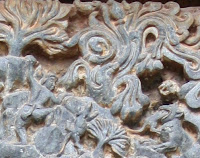In the Mahabharatha, Krishna lifts Govardhana Giri (hill), in order to provide shelter to the people and animals. A big thunderstorm that occurred in the area. Lord Krishna lifted this hill to save / rescue them. That is when Krishna came to their rescue.
 |
| Govardhana Giridhara |
This sculpture has been completed on a single-stone piece. The workmanship shows the imagination, design, planning, skill and execution of the art work. Here are some highlights of the sculpture, in no particular order of importance, beauty, or difficulty of carving.
On the top right of the carving a monkey is depicted climbing a tree, adjacent to a banana tree, which has borne fruit. It has turned its head eyeing the bananas.
 |
| Monkey gawking at bananas |
Immediate to the left of that we can see a lion (or similar feline) eating another animal, part of it already inside the mouth. A man is seen climbing the rocks on the mountain and between him and the lion is another reptile crawling up.Further left, still in the top portion, we can see a bear eyeing a bird, which itself seems to be swallowing a snake (tail hanging out of its mouth). Just next to it we see an animal entering a cave - only body, tail and hind legs seen, while rest is already inside the cave. Above the bear's head we can see a lizard crawling up the rocks, while next to it a weird animal seems seated - body of a monkey, but long mouth resembling a crocodile.In the middle of the mountain part, we can see a hunter who has shot an arrow, at a boar which is nearby. Also in this part, we can see how the sculptor has carved trees of different species.Further to the right, we see two birds eating - one upright, another pecking at the plants. Behind the birds, another lizard is clambering up the rocks. The variety of trees and creepers included takes our breath away.Below these, on the right, below the mountain, we can see people from different professions taking rest. The turbans (headgear) that they are wearing, as well as the tools of their profession are intricately put together.
Now let me describe one beautiful 4-by-6 legs depiction for the 3 humans carved on the left. 1-by-2 coffee, 2-by-3 soup are common in the last few decades. However, this artistic work, is simply superb to show 3 musician-dancers, facing 3 different directions, while the 4 legs carved make perfect positioning for the 3 people when looked at separately! See this one below, with all musician-dancers wearing anklets. Also note the scales marked on the snakes hanging from the mountain, above these people.
 |
| 3 musicians - 4 legs |
Further below on the right, we see the cows and bulls carved out of the same stone. One can see that to make the legs, the portions of rock behind it have been chipped out, making many hollow areas. Imagine the skill to ensure that the right amount is chipped out, while not damaging any important portion of the sculpture!Further to the left, at the bottom, we see more cows and bulls. Next them is a snake, which seems to have fallen from the hill. Also, the designs of the anklets, the toes, toe-nails, toe-rings, etc., are exquisite.When we look at the torso of Krishna, we can only marvel at the designs. Flower garland, the dress, the jewels, the ornaments adorning various parts of the body, fingers, nails, the ring, etc., are just some of the intricacies worked out by the sculptor.
Switching to the Krishna's crown, jewels and the hand holding the hill, we can see the perfection in proportions. What caught my eye are the details in the palm - nails, the ring and the root / snake (or whatever that is wrapped on a portion) on the hand. See the image below, on the right.
I have uploaded a full resolution picture of the entire carving to Wikimedia Commons, where you can see more photographs by others too.Can I sit and just gawk at this temple for hours? Yes, but not enough... need days just for this one temple!
After writing this blog, I realize one other thing - that we can take in little during the visit. However, for some sculptures, clicking good photos can be very useful - we can get to see in detail, what we cannot observe that well, due to the location, height or distance, of some sculptures. Still, having seen this in person, and now going through the details in the photos, gives tremendous appreciation to the architectural marvels in India.













No comments:
Post a Comment